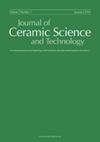复合陶瓷的实用胶体加工
IF 0.4
4区 材料科学
Q4 MATERIALS SCIENCE, CERAMICS
引用次数: 8
摘要
在陶瓷材料的形成中使用胶体加工原理,对于开发烧结产品的均匀材料性能,实现多孔陶瓷或3D打印的新成型技术,以及控制微观结构以实现优化材料性能非常受欢迎。电子陶瓷材料的固溶加工通常涉及多种阳离子元素或掺杂剂,影响其微观结构和性能。必须通过胶态处理步骤来考虑材料的稳定性,以优化所需的组分性能。这篇综述提供了在颗粒合成、铣削过程和分散过程中防止材料降解的策略,并对这些系统使用火花等离子烧结的固结进行了案例研究。通过利用类似于合成环境的条件或通过发展表面钝化层,可以防止胶体分散体中的多重腐蚀。分散表面活性剂的选择与这些表面状态有关,这对纳米颗粒体系特别重要。以钙钛矿体系为例,概述了与一些常见合成条件有关的分散剂化学性质。这些原理可以应用于许多与电子和光学应用有关的胶体系统。本文章由计算机程序翻译,如有差异,请以英文原文为准。
Practical colloidal processing of multication ceramics
The use of colloidal processing principles in the formation of ceramic materials is well appreciated for developing homogeneous material properties in sintered products, enabling novel forming techniques for porous ceramics or 3D printing, and controlling microstructure to enable optimized material properties. The solution processing of electronic ceramic materials often involves multiple cationic elements or dopants to affect microstructure and properties. Material stability must be considered through the steps of colloidal processing to optimize desired component properties. This review provides strategies for preventing material degradation in particle synthesis, milling processes, and dispersion, with case studies of consolidation using spark plasma sintering of these systems. The prevention of multication corrosion in colloidal dispersions can be achieved by utilizing conditions similar to the synthesis environment or by the development of surface passivation layers. The choice of dispersing surfactants can be related to these surface states, which are of special importance for nanoparticle systems. A survey of dispersant chemistries related to some common synthesis conditions is provided for perovskite systems as an example. These principles can be applied to many colloidal systems related to electronic and optical applications.
求助全文
通过发布文献求助,成功后即可免费获取论文全文。
去求助
来源期刊

Journal of Ceramic Science and Technology
MATERIALS SCIENCE, CERAMICS-
CiteScore
0.80
自引率
0.00%
发文量
0
期刊介绍:
The Journal of Ceramic Science and Technology publishes original scientific articles on all topics of ceramic science and technology from all ceramic branches. The focus is on the scientific exploration of the relationships between processing, microstructure and properties of sintered ceramic materials as well as on new processing routes for innovative ceramic materials. The papers may have either theoretical or experimental background. A high quality of publications will be guaranteed by a thorough double blind peer review process.
 求助内容:
求助内容: 应助结果提醒方式:
应助结果提醒方式:


